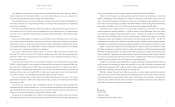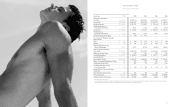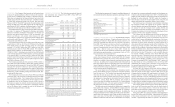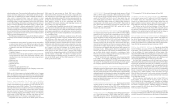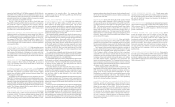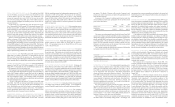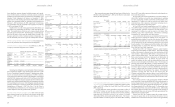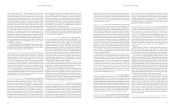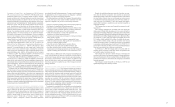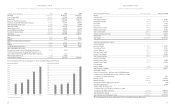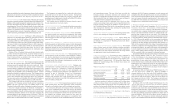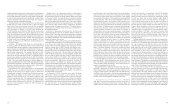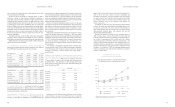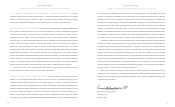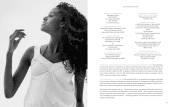Abercrombie & Fitch 2006 Annual Report Download - page 13
Download and view the complete annual report
Please find page 13 of the 2006 Abercrombie & Fitch annual report below. You can navigate through the pages in the report by either clicking on the pages listed below, or by using the keyword search tool below to find specific information within the annual report.
Uncertainty in Income Taxes – an Interpretation of FASB Statement
109, Accounting for Income Taxes” (“FIN 48”). FIN 48 provides a com-
prehensive model for how a company should recognize, measure,
present and disclose in its financial statements uncertain tax positions
that the company has taken or expects to take on a tax return. FIN 48
defines the threshold for recognizing tax return positions in the finan-
cial statements as “more likely than not” that the position is sustainable,
based on its merits. FIN 48 also provides guidance on the measure-
ment, classification and disclosure of tax return positions in the
financial statements. FIN 48 is effective for the first reporting period
beginning after December 15, 2006, with the cumulative effect of the
change in accounting principle recorded as an adjustment to the
beginning balance of retained earnings in the period of adoption.
An analysis of the impact of this interpretation is not yet complete;
however, the Company expects to record an adjustment to reduce
opening retained earnings in the first quarter of Fiscal 2007 by an
amount which is not material to its financial statements.
In September 2006, the Securities and Exchange Commission
issued Staff Accounting Bulletin (“SAB”) No. 108, “Considering the
Effects of Prior Year Misstatements when Quantifying Misstatements in
Current Year Financial Statements.” SAB No. 108 requires a “dual
approach” for quantifications of errors using both a method that
focuses on the income statement impact, including the cumulative
effect of prior years’ misstatements, and a method that focuses on the
period-end balance sheet. SAB No. 108 was effective for the Company
on February 3, 2007. The adoption of SAB No. 108 did not have any
impact on the Company’s consolidated financial statements.
In September 2006, the FASB released FASB Statement No. 157, “Fair
Value Measurements” (“SFAS 157”). SFAS 157 establishes a common def-
inition for fair value under GAAP and also establishes a framework for
measuring fair value and expands disclosure requirements about such fair
value measurements. SFAS 157 will be effective for the Company on
February 3, 2008. The Company is currently evaluating the potential
impact on the consolidated financial statements of adopting SFAS 157.
In February 2007, the FASB released FASB Statement No. 159, “The
Fair Value Option for Financial Assets and Financial Liabilities” (“SFAS 159”).
SFAS 159 permits companies to measure many financial instruments and
certain other assets and liabilities at fair value on an instrument by
instrument basis. SFAS 159 also establishes presentation and disclosure
requirements to facilitate comparisons between companies that select dif-
ferent measurement attributes for similar types of assets and liabilities.
SFAS 159 will be effective for the Company on February 3, 2008. The
Company is currently evaluating the potential impact on the consolidated
financial statements of adopting SFAS 159.
FORWARD-LOOKING STATEMENTS AND RISK FACTORS
The Company cautions that any forward-looking statements (as such
term is defined in the Private Securities Litigation Reform Act of
1995) contained in this Annual Report or made by the Company, its
management or spokespeople involve risks and uncertainties and are
subject to change based on various factors, many of which may be
beyond its control. Words such as “estimate,” “project,” “plan,”
“believe,” “expect,” “anticipate,” “intend,” and similar expressions
may identify forward-looking statements. Except as may be required
by applicable law, the Company assumes no obligation to publicly
update or revise its forward-looking statements.
The following factors could affect the Company’s financial perform-
ance and could cause actual results to differ materially from those
expressed or implied in any of the forward-looking statements:
I
changes in consumer spending patterns and consumer preferences;
I
the impact of competition and pricing pressures;
I
disruptive weather conditions affecting consumers’ ability to shop;
I
unseasonal weather conditions affecting consumer preferences;
I
availability and market prices of key raw materials;
I
ability of manufacturers to comply with applicable laws,
regulations and ethical business practices;
I
currency and exchange risks and changes in existing or potential
duties, tariffs or quotas;
I
availability of suitable store locations on appropriate terms;
I
ability to develop innovative, high-quality new merchandise in
response to changing fashion trends;
I
loss of the services of skilled senior executive officers;
I
ability to hire, train and retain qualified associates; and
I
the effects of political and economic events and conditions
domestically and in foreign jurisdictions in which the Company
operates, including, but not limited to, acts of terrorism or war.
Refer to “Item 1A. Risk Factors” of the Company’s Annual Report on
Form 10-K filed March 30, 2007 for a description of certain risk fac-
tors that the Company believes may be relevant to an understanding of
the Company and its business. These risk factors, in addition to the
factors set forth above, could cause actual results to differ materially
from those expressed or implied in any of the Company’s forward-
looking statements.
QUANTITATIVE AND QUALITATIVE DISCLOSURES
ABOUT MARKET RISK
The Company maintains its cash equiv-
alents in financial instruments with original maturities of 90 days or less.
The Company also holds investments in marketable securities, which pri-
marily consist of investment grade municipal notes and bonds and
investment grade auction rate securities, all classified as available-for-
sale and have maturities ranging from three months to forty years. These
securities are consistent with the investment objectives contained
within the investment policy established by the Company’s Board of
Directors. The basic objectives of the investment policy are the preser-
vation of capital, maintaining sufficient liquidity to meet operating
requirements and maximizing net after-tax yield.
Investments in municipal notes and bonds have early redemption
provisions at predetermined prices. Taking these provisions into
account, none of these investments extend beyond five years. The
Company believes that a significant increase in interest rates could
result in a material loss if the Company sells the investment prior to
the early redemption provision. For Fiscal 2006, there were no real-
ized gains or losses, and as of February 3, 2007, net unrealized holding
losses were approximately $0.7 million.
Abercrombie &Fitch
Despite the underlying long-term maturity of auction rate secu-
rities, from the investor’s perspective, such securities are priced and
subsequently traded as short-term investments because of the interest
rate reset feature. Interest rates are reset through an auction process
at predetermined periods ranging from seven to 49 days. Failed auc-
tions rarely occur. As of February 3, 2007, the Company held approx-
imately $447.8 million in available-for-sale securities classified as
marketable securities.
The Company does not enter into financial instruments for trad-
ing purposes.
The Company established an irrevocable rabbi trust during the
third quarter of Fiscal 2006, the purpose is to be a source of funds to
match respective funding obligations to participants in the Abercrombie
& Fitch Nonqualified Savings and Supplemental Retirement Plan and
the Chief Executive Officer Supplemental Executive Retirement Plan.
As of February 3, 2007, total assets related to the Rabbi Trust were
$33.5 million, which included $18.3 million of available-for-sale secu-
rities and $15.3 million related to the cash surrender value of trust
owned life insurance policies. The Rabbi Trust assets are consolidated
in accordance with Emerging Issues Task Force 97-14 (“EITF 97-14”)
and recorded at fair value in other assets on the Consolidated Balance
Sheet and were restricted as to their use as noted above.
As of February 3, 2007 the Company had no long-term debt out-
standing. Future borrowings would bear interest at negotiated rates
and would be subject to interest rate risk.
The Company has exposure to adverse changes in exchange rates
associated with revenues and operating expenses of foreign operations,
which are denominated in Euros, Canadian Dollars and British Pounds,
but believes this exposure is immaterial to the Company’s consolidated
financial statements.
The Company’s market risk profile as of February 3, 2007 has not
significantly changed since January 28, 2006.
Abercrombie &Fitch
2524



